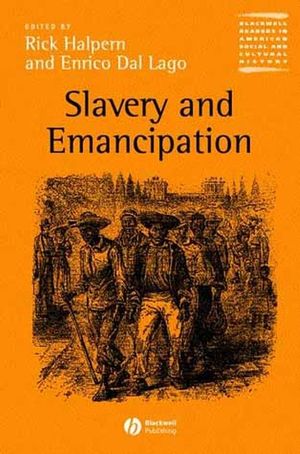Slavery and EmancipationISBN: 978-0-631-21735-0
Paperback
436 pages
November 2002, Wiley-Blackwell
 This is a Print-on-Demand title. It will be printed specifically to fill your order. Please allow an additional 10-15 days delivery time. The book is not returnable.
Other Available Formats: Hardcover
|
||||||
Part I: Colonial Origins: Race and Slavery:.
Introduction.
Documents:.
A. The First Blacks Arrive In Virginia (1619).
B. Slavery Becomes A Legal Fact In Virginia (17th Century Statutes).
C. South Carolina Restricts The Liberty Of Slaves (1740).
Article: Philip D. Morgan, Two Infant Slave Societies In The Chesapeake And The Lowcountry (From Slave Counterpoint, 1998).
Part II: From African To African-American: Slave Adaptation To The New World:.
Introduction.
Documents:.
A. Olaudah Equiano Describes His Capture (1760).
B. Slave Cargo List, South Carolina (1730).
C. List Of Fugitive Slave Skills, Virginia (18th Century).
Article: Ira Berlin, The Plantation Generation Of African Americans (From Many Thousands Gone, 1998).
Part III: The Formation of The Master Class:.
Introduction.
Documents:.
A. William Byrd Ii Describes The Patriarchal Ideal (1726).
B. Reverend Jarratt Observes The Life-Style Of Virginia's Planters (1750).
C. Thomas Jefferson Gives Instructions To His Overseer (1774-1790).
Article: Kathy Brown, Masters And Mistresses In Colonial Virginia (From Good Wives, Nasty Wenches, And Anxious Patriarchs, 1996).
Part IV: Slavery and The American Revolution:.
Introduction.
Documents:.
A. Lord Dunmore's Proclamation Freeing Slaves In Virginia (1775).
B. Virginia's Manumission Law (1782).
C. Thomas Jefferson Expresses His Unease Over Slavery (1782).
Article: Peter Kolchin, Slavery And The American Revolution (From American Slavery, 1993).
Part V: The Growth of The Cotton Kingdom:.
Introduction.
Documents:.
A. Joseph Baldwin On Cotton Planters In Alabama And Mississippi (1836).
B. James Henry Hammond On Agriculture In The Upper South (1841).
C. Frederick Law Olmsted On The Profitability Of Cotton (1856).
Article: Mark Smith, Debating The Profitability Of Antebellum Southern Agriculture (From Debating Slavery, 1998).
Part VI: The World of The Planters:.
Introduction.
Documents:.
A. John Lyde Wilson, “The Code Of Honor” (1838).
B. George Fitzhugh On The Benefits Of Slavery (1857).
C. George Cary Eggleston Remembers Aristocratic Life In Virginia (1875).
Article: Eugene Genovese, The Slaveholders' Dilemma Between Slavery And Progress (From The Slaveholders' Dilemma, 1992).
Part VII: Life Within The Big House:.
Introduction.
Documents:.
A. Adele Petigru Is Reminded Of The Mistress' Duties By Her Aunt (C. 1830s).
B. Rosalie Roos On Marriages In South Carolina (1854).
C. Mary Chesnut Describes The Effects Of Patriarchy (1861).
Article: Marli Wiener, Mistresses And Slaves In A Patriarchal World (From Mistresses And Slaves (1998).
Part VIII: Masters And Slaves: Paternalism And Exploitation:.
Introduction.
Documents:.
A. James Henry Hammond Battles Slave Illness (1841).
B. Rules On The Rice Estate Of Plowden C. Weston (1846).
C. Charles Manigault Instructs His Overseer About “My Negroes” (1848).
Article: Walter Johnson, The Chattel Principle (From Soul By Soul, 1999).
Part IX: Life In The Slave Quarters:.
Introduction.
Documents:.
A. Frederick Douglass Remembers His Childhood (1845).
B. Tempie Herndon Remembers Her Wedding (1860).
C. Daniel Drake Remembers A Corn-Shucking Ceremony (1870).
Article: Brenda Stevenson, Slave Marriage And Family Life In Antebellum Virginia (From Life In Black And White, 1996).
Part X: Slave Resistance And Slave Rebellion:.
Introduction.
Documents:.
A. Excerpts From Denmark Vesey's Trial Transcript (1822).
B. Frederick Douglass Remember Resisting His Overseer (1845).
C. Frederick Law Olmsted On Slave Runaways In Virginia (1856).
Article: John Hope Franklin And Loren Schweninger, The Impact Of Runaway Slaves On The Slave System (From Runaway Slaves, 1999).
Part XI: The Abolitionist Impulse:.
Introduction.
Documents:.
A. William Lloyd Garrison, “I Will Be Heard” (1831).
B. Massachussets Anti-Slavery Society Resolution (1843).
C. Frederick Douglass Discusses The Fourth Of July (1852).
Article: Paul Goodman, Abolitionists And The Origins Of Racial Equality (From Of One Blood, 1998).
Part XII: The Politics of Slavery:.
Introduction.
Documents:.
A. John C. Calhoun's Address To The People Of The United States (1832).
B. The New York Tribune On The Radical Origins Of Republicans (1855).
C. Abraham Lincoln's House Divided Speech (1858).
Article: Don E. Fehrenbacher, Slavery And Territorial Expansion (From The Slaveholding Republic, 2001).
Part XIII: Secession and Civil War:.
Introduction.
Documents:.
A. South Carolina's Ordinance Of Secession (1860).
B. Mary Chesnut Recalls The Beginning Of The War (1861).
C. Gertrude Thomas On The Role Of Slave Mistresses During The War (1863).
Article: Drew Faust, Confederate Women In The Crisis Of The Slaveholding South (From Mothers Of Invention, 1996).
Part XIV: Emancipation and The Destruction Of Slavery:.
Introduction.
Documents:.
A. Abraham Lincoln's Emancipation Proclamation (1863).
B. Frederick Douglass, “Men Of Color, To Arms” (1863).
C. Selections Of Documents On The Black Military Experience (1863-1865).
Article: Ira Berlin Et Al., The Destruction Of Slavery (From Slaves No More, 1992)



